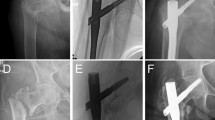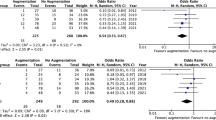Abstract
Purpose
This study aimed to determine the efficacy and safety of cement augmentation for internally fixed trochanteric fractures through a systematic review and meta-analysis of randomized controlled trials (RCTs).
Methods
We searched the MEDLINE, EMBASE, Cochrane Central Register of Controlled Trials, World Health Organization International Clinical Trials Registry Platform, and ClinicalTrials.gov databases to identify RCTs, published until July 2020 that examined the effects of cement augmentation of internal fixation of trochanteric fractures. The primary outcomes were reoperation and Parker Mobility Score, whereas the secondary outcomes were 1-year mortality rate, EuroQol 5 Dimension, fixation failures, and adverse events. We conducted meta-analyses of the outcome measures using the random-effects models. We evaluated the certainty of evidence based on the Cochrane risk-of-bias tool and the Grading of Recommendations, Assessment, Development, and Evaluation approach.
Results
We included three RCTs (326 participants). No significant effect was observed in favor of cement augmentation on all these outcomes. The certainty of evidence for fixation failures was very low and that for the other outcomes was low. The overall risk of bias for each outcome was high or of some concern in all included studies.
Conclusions
The effect of cement augmentation of internal fixation of trochanteric fractures was uncertain for the clinical outcomes due to the low certainty of evidence. Further RCTs with a low risk of selection bias may present convincing conclusions on the efficacy and safety of cement augmentation.
Level of evidence
Level 1






Similar content being viewed by others
References
Hagino H, Endo N, Harada A, Iwamoto J, Mashiba T, Mori S, et al. Survey of hip fractures in Japan: recent trends in prevalence and treatment. J Orthop Sci. 2017;22:909–14.
Tucker A, Donnelly KJ, McDonald S, Craig J, Foster AP, Acton JD. The changing face of fractures of the hip in Northern Ireland: a 15-year review. Bone Joint J. 2017;99-B:1223–31.
Hartholt KA, van Beeck EF, Polinder S, Polinder S, van der Velde N, van Lieshout EM, et al. Societal consequences of falls in the older population: injuries, healthcare costs, and long-term reduced quality of life. J Trauma. 2011;71:748–53.
Sommers MB, Roth C, Hall H, Kam BC, Ehmke LW, Krieg JC, et al. A laboratory model to evaluate cutout resistance of implants for pertrochanteric fracture fixation. J Orthop Trauma. 2004;18:361–8.
Ehmke LW, Fitzpatrick DC, Krieg JC, Madey SM, Bottlang M. Lag screws for hip fracture fixation: evaluation of migration resistance under simulated walking. J Orthop Res. 2005;23:1329–35.
Bojan AJ, Jönsson A, Granhed H, Ekholm C, Kärrholm J. Trochanteric fracture-implant motion during healing—a radiostereometry (RSA) study. Injury. 2018;49:673–9.
Kammerlander C, Gebhard F, Meier C, Lenich A, Linhart A, Clasbrummel B, et al. Standardised cement augmentation of the PFNA using a perforated blade: a new technique and preliminary clinical results. A prospective multicentre trial. Injury. 2011;42:1484–90.
Kammerlander C, Doshi H, Gebhard F, Scola A, Meier C, Linhart W, et al. Long-term results of the augmented PFNA: a prospective multicenter trial. Arch Orthop Trauma Surg. 2014;134:343–9.
Mattsson P, Larsson S. Unstable trochanteric fractures augmented with calcium phosphate cement. A prospective randomized study using radiostereometry to measure fracture stability. Scand J Surg. 2004;93:223–8.
Mattsson P, Alberts A, Dahlberg G, Sohlman M, Hyldahl HC, Larsson S. Resorbable cement for the augmentation of internally-fixed unstable trochanteric fractures. A prospective, randomised multicentre study. J Bone Joint Surg Br. 2005;87:1203–9.
Dall’Oca C, Maluta T, Moscolo A, Lavini F, Bartolozzi P. Cement augmentation of intertrochanteric fractures stabilised with intramedullary nailing. Injury. 2010;41:1150–5.
Yamamoto N, Ogawa T, Banno M, Watanabe J, Noda T, Schermann H, et al. Protocol: Cement augmentation of internal fixation for trochanteric fracture: protocol for a systematic review and meta-analysis V.6. 2020. https://www.protocols.io/view/protocol-cement-augmentation-of-internal-fixation-bkg2ktye. Accessed 5 Oct 2020.
Higgins J, Thomas J, Chandler J, Cumpston M, Li T, Page MJ, et al. Cochrane Handbook for Systematic Reviews of Interventions Version 6. updated Ma. The Cochrane Collaboration. 2019. www.cochrane-handbook.org.
Liberati A, Altman DG, Tetzlaff J, Mulrow C, Gøtzsche PC, Loannidis JPA, et al. The PRISMA statement for reporting systematic reviews and meta-analyses of studies that evaluate health care interventions: explanation and elaboration. PLoS Med. 2009;6:e1000100.
Moher D, Liberati A, Tetzlaff J, Altman DG, PRISMA Group. Preferred reporting items for systematic reviews and meta-Analyses: the PRISMA statement. PLoS Med. 2009;6:1000097.
Meinberg EG, Agel J, Roberts CS, Karam MD, Kellam JF. Fracture and dislocation classification compendium-2018. J Orthop Trauma. 2018;32:S1-170.
Parker MJ, Palmer CR. A new mobility score for predicting mortality after hip fracture. J Bone Joint Surg Br. 1993;75:797–8.
Brooks R. EuroQol: the current state of play. Health Policy. 1996;37:53–72.
Herdman M, Gudex C, Lloyd A, Janssen MF, Kind P, Parkin D, et al. Development and preliminary testing of the new five-level version of EQ-5D (EQ-5D-5L). Qual Life Res. 2011;20:1727–36.
Janssen MF, Pickard AS, Golicki D, Gudex C, Niewada M, Scalone L, et al. Measurement properties of the EQ-5D-5L compared to the EQ-5D-3L across eight patient groups: a multi-country study. Qual Life Res. 2013;22:1717–27.
Haywood KL, Griffin XL, Achten J, Costa ML. Developing a core outcome set for hip fracture trials. Bone Joint J. 2014;96-B:1016–23.
National Clinical Guideline Centre (UK). The management of hip fracture in adults. London: Royal College of Physicians (UK). 2011. https://pubmed.ncbi.nlm.nih.gov/22420011/. Accessed 5 Oct 2020.
AAOS. Evidence-based clinical practice guideline: management of hip fracture in the elderly. AAOS. 2014;1–521.
Chaimani A, Mavridis D, Higgins JPT, Salanti G, White IR. Allowing for informative missingness in aggregate data meta-analysis with continuous or binary outcomes: extensions to metamiss. Stata J. 2018;18:716–40.
Guyatt G, Oxman AD, Akl EA, Kunz R, Vist G, Brozek J, et al. GRADE guidelines: 1. Introduction—GRADE evidence profiles and summary of findings tables. J Clin Epidemiol. 2011;64:383–94.
Kammerlander C, Hem ES, Klopfer T, Gebhard F, Sermon A, Dietrich M, et al. Cement augmentation of the Proximal Femoral Nail Antirotation (PFNA)—a multicentre randomized controlled trial. Injury. 2018;49:1436–44.
Berger-Groch J, Rupprecht M, Schoepper S, Schroeder M, Rueger JM, Hoffmann M. Five-year outcome analysis of intertrochanteric femur fractures: a prospective randomized trial comparing a 2-screw and a single-screw cephalomedullary nail. J Orthop Trauma. 2016;30:483–8.
Erhart S, Schmoelz W, Blauth M, Lenich A. Biomechanical effect of bone cement augmentation on rotational stability and pull-out strength of the Proximal Femur Nail AntirotationTM. Injury. 2011;42:1322–7.
Knobe M, Bettag S, Kammerlander C, Altgassen S, Maier KJ, Nebelung S, et al. Is bone-cement augmentation of screw-anchor fixation systems superior in unstable femoral neck fractures? A biomechanical cadaveric study. Injury. 2019;50:292–300.
Namdari S, Rabinovich R, Scolaro J, Baldwin K, Bhandari M, Mehta S. Absorbable and non-absorbable cement augmentation in fixation of intertrochanteric femur fractures: systematic review of the literature. Arch Orthop Trauma Surg. 2013;133:487–94.
Leonardo S, Salvatore R, Francesco M, Davide P, Giuseppe R, Lawrence C. Cement augmentation for trochanteric fracture in elderly: a systematic review. J Clin Orthop Trauma. 2020. https://doi.org/10.1016/j.jcot.2020.10.034.
Tsukada S, Okumura G, Matsueda M. Postoperative stability on lateral radiographs in the surgical treatment of pertrochanteric hip fractures. Arch Orthop Trauma Surg. 2012;132:839–46.
Kozono N, Ikemura S, Yamashita A, Harada T, Watanabe T, Shirasawa K. Direct reduction may need to be considered to avoid postoperative subtype P in patients with an unstable trochanteric fracture: a retrospective study using a multivariate analysis. Arch Orthop Trauma Surg. 2014;134:1649–54.
Bojan AJ, Beimel C, Taglang G, Collin D, Ekholm C, Jönsson A. Critical factors in cut-out complication after Gamma Nail treatment of proximal femoral fractures. BMC Musculoskelet Disord. 2013;14:1.
Ito J, Takakubo Y, Sasaki K, Sasaki J, Owashi K, Takagi M. Prevention of excessive postoperative sliding of the short femoral nail in femoral trochanteric fractures. Arch Orthop Trauma Surg. 2015;135:651–7.
Schuetze K, Ehinger S, Eickhoff A, Dehner C, Gebhard F, Richter PH. Cement augmentation of the proximal femur nail antirotation: is it safe? Arch Orthop Trauma Surg. 2020. https://doi.org/10.1007/s00402-020-03531-2.
Goodnough LH, Wadhwa H, Tigchelaar SS, DeBaun MR, Chen MJ, Bishop JA, et al. Trochanteric fixation nail advanced with helical blade and cement augmentation: early experience with a retrospective cohort. Eur J Orthop Surg Traumatol. 2020. https://doi.org/10.1007/s00590-020-02762-8.
Yee DKH, Lau W, Tiu KL, Leung F, Fang E, Paolo J, et al. Cementation: for better or worse? Interim results of a multi-centre cohort study using a fenestrated spiral blade cephalomedullary device for pertrochanteric fractures in the elderly. Arch Orthop Trauma Surg. 2020. https://doi.org/10.1007/s00402-020-03449-9.
Acknowledgements
We thank Dr. Yasushi Tsujimoto for providing the detailed information on the sensitivity analysis. This work was supported by the Systematic Review Workshop Peer Support Group (SRWS-PSG). We thank Editage (www.editage.jp) for their English editing services.
Funding
There is no funding source.
Author information
Authors and Affiliations
Contributions
All authors contributed to the study conception and design. Data collection was performed by NY, TO, and HS. Data analysis was performed by NY, TO, JW, and MB. The first draft of the manuscript was written by NY and all authors commented on previous versions of the manuscript. All authors read and approved the final manuscript.
Corresponding author
Ethics declarations
Conflict of interest
The authors declare that they have no conflict of interest.
Ethical approval
This article does not contain any studies with human participants or animals performed by any of the authors.
Supplementary Information
Below is the link to the electronic supplementary material.
Rights and permissions
About this article
Cite this article
Yamamoto, N., Ogawa, T., Banno, M. et al. Cement augmentation of internal fixation for trochanteric fracture: a systematic review and meta-analysis. Eur J Trauma Emerg Surg 48, 1699–1709 (2022). https://doi.org/10.1007/s00068-021-01746-5
Received:
Accepted:
Published:
Issue Date:
DOI: https://doi.org/10.1007/s00068-021-01746-5




